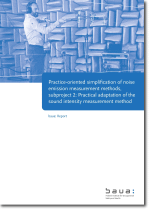Practice-oriented simplification of noise emission measurement methods, subproject 2: Practical adaptation of the sound intensity measurement method
The sound power level quantifies the total amount of sound emitted by a source. It is therefore used for regulatory purposes within the framework of occupational health, environmental protection and consumer information. The measurement of the sound power level is internationally harmonised in about ten different ISO-standards. Despite the fact that the sound intensity method is the most recent one, it is seldom used in practice for various reasons. This was the main motivation to initiate this research project.
Starting point for the project is a thorough analysis of the existing knowledge on the physical background of sound intensity measurement using two-microphone-probes. Limitations due to the finite difference approximation of the pressure gradient and due to the phase mismatch between the two microphone channels are mathematically expressed.
This is followed by purely analytical calculations where the sound field emitted by a single monopole and a single dipole is superposed by a plane wave and a diffuse sound field. The sound power level calculated from the sound intensity in normal direction to an enveloping surface is compared to the known sound power level of the sources. Varying the relation between the amplitudes of the different sound fields suggests that from the currently used sound field indicators only the signed pressure intensity indicator is useful. Neither the unsigned pressure intensity indicator nor the sound field inhomogeneity indicator provides additional information on the quality of the obtained sound power level.
From these findings, proposals for a major simplification of the sound intensity measurement method are derived. The proposals are checked by a comprehensive measurement program executed at PTB. Four different sources with different spectral characteristics and directivity are measured in different surroundings using manual scanning, automatic scanning and discrete measurement points. Measurement results confirm the theoretical findings to a large extent.
Finally, standard documents are drafted where the findings of the project are included. For this, a totally new approach is proposed by always measuring in one-third octave bands between 50 Hz and 10 kHz and calculating the A-weighted sound power level from these frequency bands with possibly different grades of accuracy.
Bibliographic information
Title: Practice-oriented simplification of noise emission measurement methods, subproject 2: Practical adaptation of the sound intensity measurement method.
1. edition. Dortmund: Bundesanstalt für Arbeitsschutz und Arbeitsmedizin, 2021. pages: 263, Project number: F 2450, PDF file, DOI: 10.21934/baua:report20210914
